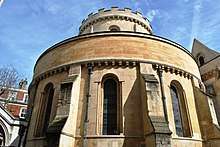John Hoyle (died 1692)

John Hoyle (died May 1692) was a bisexual lawyer in London and an alleged lover of the writer Aphra Behn.[1][2]
Family
John Hoyle was the son and heir of Thomas Hoyle. Thomas Hoyle (baptised 29 January 1587 - died 30 January 1650) was a parliamentarian in the Civil War and he was appointed lord mayor of York following the city’s capture in July 1644. He joined the regicides after some hesitation, but regretting what they did, he hanged himself on the first anniversary of the King Charles I’s execution.[3]
Career and personal life
John Hoyle, born in the city of York, was a lawyer who received his training at Gray's Inn[2] and was a member of the Inner Temple,[4] London. While still a law student, in 1663, he stabbed an unarmed watchmaker, who died six days later.[5] Despite a number of witnesses against him, he escaped the murder charge with a verdict of ignoramus, i.e. there was not sufficient evidence to convict him.[5]
In 1687, Hoyle was arrested and tried for sodomy.[4] The grand jury returned a verdict of ignoramus.[6]
Aphra Behn
In the 1670s, he was an intimate of the pioneering woman writer and playwright Aphra Behn. Their relationship was tumultuous.[7][6] In Tom Brown's "Letters of Love and Gallants", there is a letter from Aphra Behn to Hoyle, remonstrating with him on his depraved way of life, and asking him in the name of "Our past endearments" to clear himself, if possible, of the allegations made against him.[8] He figures in much of Behn's writings[9] and is thought to be one of the two models for the promiscuous protagonist of Behn's 1677 play The Rover.[10] Behn died in 1689 and is buried in Westminster Abbey. John Hoyle is believed to have written the epitaph on her black marble stone: "Here lies a proof that wit can never be / Defense enough against mortality."[2]
Death
In May 1692, he was stabbed to death "after a drunken brawl in a tavern"[6] and is buried in the vault belonging to the Inner Temple Church.
References
- ↑ Melanie McGrath (2 November 1996). "Restoration kerfuffle". The Independent.
- 1 2 3 Cynthia Caywood (1997). "A Tour of Aphra Behn's London" (PDF). (updated 2010)
- ↑ "HOYLE, Thomas (1587-1650), of St. Martin-cum-Gregory, Micklegate, York; later of Broad Sanctuary, Westminster"
- 1 2 "Sentence of John Hoyle of Inner Temple, Middlesex". The National Archives (United Kingdom). 8 July 1692.
- 1 2 Todd, Janet (19 September 2013). The Secret Life of Aphra Behn. A&C Black. p. 169. ISBN 9781448212545. Retrieved 20 July 2017.
- 1 2 3 Atchley, Amy Margaret, "Aphra Behn and Susanna Centlivre: A Materialist-Feminist Study." (1995). LSU Historical Dissertations and Theses. 5940.
- ↑ Castle, Terry (2003). The Literature of Lesbianism: A Historical Anthology from Ariosto to Stonewall. Columbia University Press. p. 171. ISBN 9780231125109. Retrieved 20 July 2017.
- ↑ Bridget G. MacCarthy (1994). The Female Pen: Women Writers and Novelists, 1621-1818. NYU Press. p. 252.
- ↑ Mary Ann O'Donnell. "Aphra Behn: the documentary record (excerpt from The Cambridge Companion to Aphra Behn)".
- ↑ Castle, Terry (2003). The Literature of Lesbianism: A Historical Anthology from Ariosto to Stonewall. Columbia University Press. p. 171. ISBN 9780231125109. Retrieved 17 July 2017.
External links
- "Aphra Behn and John Hoyle: A contemporary mention, and Sir Charles Sedley's poem on his death", an article about the relationship between Behn and Hoyle by P. A. Hopkins in Notes & Queries (subscription required)